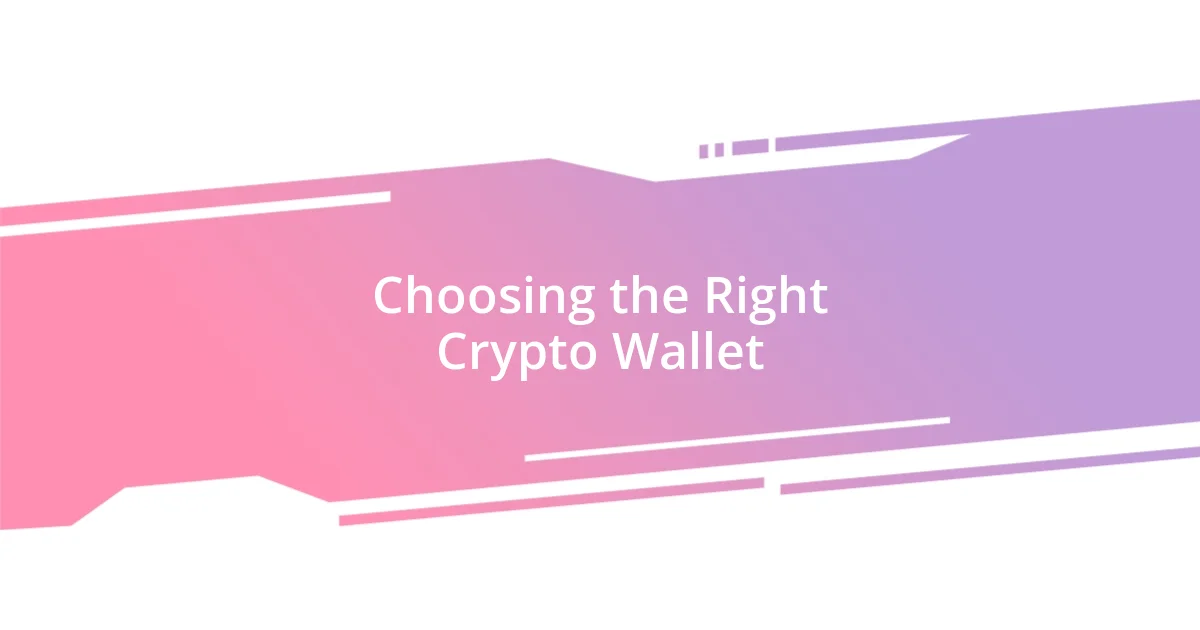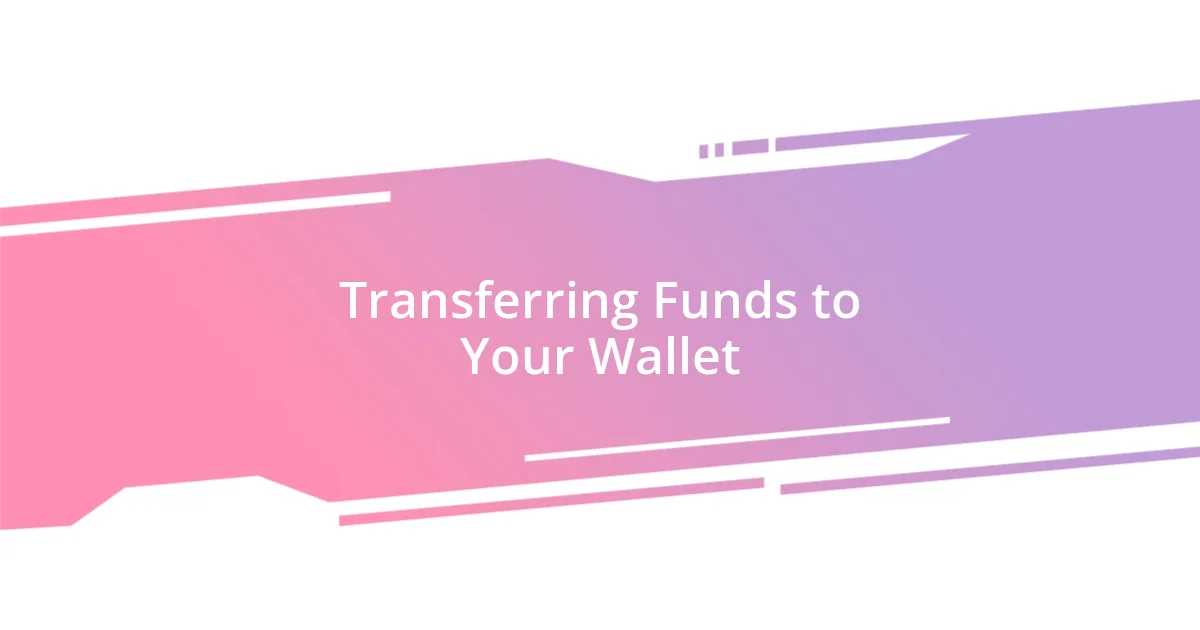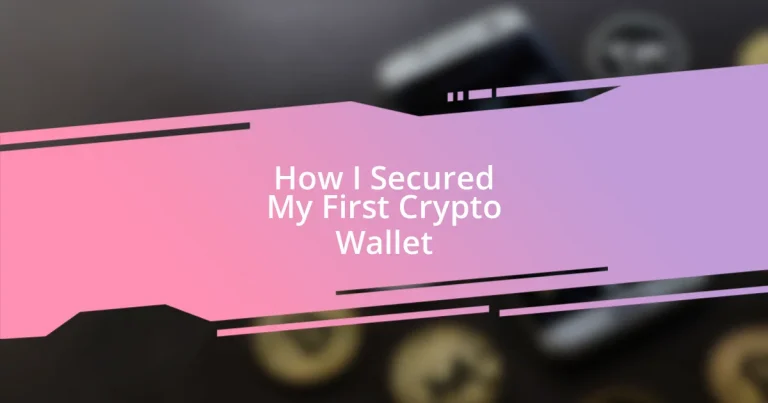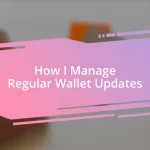Key takeaways:
- Choosing the right crypto wallet involves balancing security and convenience, with options including hardware, software, and paper wallets, each having distinct pros and cons.
- Securing your wallet is crucial; essential practices include using strong passwords, enabling two-factor authentication, and regularly backing up your wallet and seed phrase.
- Avoid common pitfalls such as relying on a single backup, neglecting software updates, and not educating yourself on phishing scams to protect your digital assets.

Understanding Crypto Wallets Basics
When I first dove into the world of cryptocurrency, the idea of a crypto wallet seemed daunting. I remember feeling overwhelmed, wondering how I could keep my digital assets safe. But understanding that a crypto wallet is just a secure space for storing your private keys gave me a sense of relief. It’s essentially your gateway to managing cryptocurrencies, like Bitcoin or Ethereum.
I discovered that there are different types of wallets—hardware, software, and paper wallets, each with its unique features. For instance, hardware wallets felt like a physical safe for my assets, while software wallets were more convenient for daily use. Have you thought about how you would use your wallet? I found it helpful to align my choice with my own spending habits and security preferences.
Another eye-opener for me was realizing that while wallets store your keys, they don’t hold the actual currency. This realization shifted my perspective on security. With my first wallet, I learned the importance of backing up my keys. It’s like having a backup plan for when life throws unexpected curveballs. Have you considered what you’d do if you lost access to your wallet? Trust me, a solid backup can be the difference between a minor hiccup and a financial disaster.

Choosing the Right Crypto Wallet
Choosing the right crypto wallet can feel like navigating a maze for the first time. I remember spending countless nights researching, comparing features, and analyzing security measures. One of the critical aspects I focused on was how easily I could access my wallet; convenience versus security was a constant tug-of-war for me. Ultimately, I realized that the best choice depended on my own usage patterns and how much risk I was willing to take.
Throughout my journey, I learned to appreciate the nuances of each wallet type. For example, hardware wallets provided peace of mind with their robust security, but I didn’t want to lug around a USB device every time I made a transaction. On the other hand, the software wallets offered impressive accessibility, but I couldn’t shake the lingering fear of potential hacks. Balancing these considerations often felt overwhelming, yet it was also part of the thrill of entering the crypto world.
When deciding on a wallet, I suggest making a list of your primary needs. Do you prioritize mobility, convenience, or sheer security? My personal experience taught me that a good fit will depend on how you envision using your crypto. I started with a software wallet for trading but eventually moved to a hardware wallet for my long-term holdings. Trust me; knowing my assets were snug in a secure environment brought immense satisfaction.
| Wallet Type | Pros | Cons |
|---|---|---|
| Hardware Wallet | High security, offline storage | Hardware can be lost, less convenient |
| Software Wallet | Easy to access, user-friendly | Vulnerable to hacks, depends on internet access |
| Paper Wallet | Physical control, offline | Risk of damage or loss, not user-friendly for transactions |

Setting Up Your Crypto Wallet
Setting up my first crypto wallet felt like an adventure, albeit a slightly nerve-wracking one. I remember when I finally decided to take the plunge. I meticulously followed the steps to download the wallet software, making sure to choose a reputable one. Once I launched the app, a mix of excitement and anxiety washed over me; this was my gateway to the crypto universe!
Here’s a simplified checklist based on my experience with setting up a wallet:
- Choose a Reputable Wallet: Research to find one with strong reviews and security features that fit your needs.
- Download and Install: Follow the instructions to install the software on your device.
- Create Your Wallet: I was prompted to create a new wallet, which involved setting a secure password. I made sure my password was complex yet memorable.
- Backup Your Seed Phrase: I wrote down my unique recovery phrase, storing it in a safe place. It’s my lifeline!
- Enable Two-Factor Authentication: I set this up to add an extra layer of security; it gave me peace of mind.
In the middle of the setup, I had this genuine realization of the importance of keeping my wallet safe. The thought that my digital assets rested in my hands, rather than a bank, thrilled and terrified me. This was my first step into a new realm, and properly securing my wallet became my top priority right from the start. That little leap turned into a significant step toward financial independence and empowerment.

Securing Your Crypto Wallet
Securing your crypto wallet is like locking the door to your home; you wouldn’t leave it wide open for anyone, would you? After I set up my wallet, I quickly realized that security was my priority. I started using a strong, unique password that mixed letters, numbers, and symbols. I knew firsthand the consequences of weak passwords when I heard stories about friends losing their funds due to hacks. It instilled in me a sense of urgency to fortify my defenses.
One of the first things I did was enable two-factor authentication (2FA). It felt good to know that even if someone managed to get my password, they would still need a second piece of information to access my wallet. This additional layer of security not only gave me peace of mind but also gave me more control over my assets. Have you ever felt that pit in your stomach when you’re unsure about the safety of your valuables? I certainly have, and that’s what spurred me to take every precaution I could think of.
I also made it a habit to regularly back up my wallet and seed phrase in multiple secure locations. The day I tucked away that handwritten note in a safe deposit box, I felt a wave of relief wash over me. I thought, what if something happens to my device? With my backups in place, I knew I could recover my funds no matter what. It’s these small but impactful steps that allow you to sleep soundly at night, knowing your digital assets are secure.

Transferring Funds to Your Wallet
Transferring funds to my wallet was a pivotal moment, something I had been preparing for weeks. I remember the rush of anticipation as I entered the first transaction details; it felt like I was taking real ownership of my digital assets. My first transfer was from an exchange, and I made sure to double-check the wallet address—one wrong character could lead to lost funds. Have you ever experienced that heart-stopping moment when you’re about to send a sizable amount of money? I certainly did, and it was crucial to remain calm and focused.
Once everything was set up, I initiated the transfer, watching the screen anxiously for the confirmation. I recall how the dread crept in as I pondered whether it would actually go through. After a few moments that felt like an eternity, there it was—my funds had arrived! The feeling of success was overwhelming; finally, I was officially part of the crypto world. And although I was ecstatic, the experience also taught me the importance of patience in this digital landscape.
In those early days, I came to realize that knowing how to monitor the transaction was just as important. There are tools available that let you track your transfers on the blockchain; this was a game changer for me. It empowered me to visualize my holdings, and seeing my crypto assets confirmed on the blockchain felt like a badge of honor. Have you started tracking your transactions yet? If not, I highly recommend diving into the world of block explorers; it adds another layer of engagement to your crypto journey.

Common Mistakes to Avoid
One common mistake I’ve noticed is relying solely on a single backup for your wallet. Initially, I thought a single secure location would be enough, but the anxiety of misplacing that backup was constant. Imagine losing access to everything because of one oversight—it’s a nightmare that’s all too real for many.
Another pitfall I fell into was ignoring software updates. I remember feeling hesitant about some notifications, thinking they weren’t urgent. But after a close call with a malware attack that targeted outdated wallets, I learned the hard way how critical it is to keep everything current. Do you really want to put your investments at risk over a few clicks? I certainly didn’t want to again.
Lastly, not educating myself on phishing scams was a rookie mistake. I used to think I could identify fake emails or websites, but I got caught off guard once. It was a jarring experience that made my heart race when I realized I clicked the wrong link. It’s an easy trap for anyone to fall into—have you taken the time to learn how to spot these scams? Trust me, it’s a lesson worth learning before it’s too late.

Tips for Wallet Maintenance
Maintaining your crypto wallet is just as important as setting it up. One of the best practices I adopted was regularly checking my wallet for any discrepancies. I remember a moment when I glanced over my balance and found a small amount missing—it turned out I had mistakenly sent it to the wrong address. Have you ever conducted a “balance check”? It’s a simple step that can save you a lot of heartache.
Another tip I swear by is to keep a separate device for wallet access. I learned this the hard way after accidentally clicking on a suspicious link while using my main computer. The realization that I might have compromised my wallet sent chills down my spine! Using a dedicated device adds a layer of security that I highly recommend. Have you considered this approach? It has significantly eased my mind knowing that my wallet has a dedicated fortress.
Lastly, always remember to securely store your recovery phrases in multiple locations. I once stashed mine in a notebook that I later misplaced during a move. The panic was real, and I felt as if a weighty anchor was pulling me down. Ever thought about what would happen if access to your digital assets slipped through your fingers? I took that experience as a reminder to make my recovery phrases virtually unloseable!














